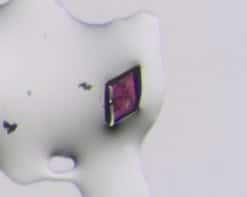
The first nanofabrication technique that overcomes the three “grand challenges in nanofabrication” has been unveiled by researchers in the US. The technique, dubbed solvent-assisted nanoscale embossing (SANE), could be used to make cheap large-area nanoscale patterns in applications like plasmonics, solar cells and data storage.
At present, scientists use electron-beam lithography or focused ion beam milling to create patterns at nanometre length scales. However, such techniques are not practical for mass production because they must start from scratch each time and the patterns cannot be made over large areas. Moulding, imprint lithography and soft lithography can mass produce patterns, but these methods are limited to the fixed features on the mould or the original master template.
Teri Odom and colleagues at Northwestern University have now developed SANE as a way around these problems. The technique meets three grand challenges in nanofabrication: it can alter the density of nano-arrays; reduce critical feature sizes; and configure different lattice symmetries. Key to SANE is that all three of these challenges can be met starting from the same master pattern, says Odom.
Unlimited master and mould patterns
The researchers showed that they could tune array densities from 300% above to 75% below the density of a master pattern. SANE can also be used to decrease feature sizes while keeping array spacing constant by applying different solvents during the procedure. And most importantly, the technique can be used to make an unlimited supply of new master and mould patterns.
SANE is also cheap: no other existing nanopatterning method can prototype arbitrary patterns with small separations and implement them over 6" wafers for less than $100, explains Odom.
To demonstrate their technique, the Northwestern researchers started with a 6″ diameter polyurethane master with 180 nm features separated by 400 nm. Next, they cast an elastomer (poly(dimethylsiloxane), or PDMS) against the master to create PDMS moulds. The moulds were first wet with solvent and then placed in contact with a photoresist-coated substrate.
Higher array densities
To create patterns with higher array densities, the team heated a photoresist placed on “shrink film” in an oven at 115 °C. After 20 minutes, the thermoplastic substrate shrank by a third and the lattice spacing also decreased by this amount. This technique thus easily produces a new master covering an area of 10 cm2 with a density that is twice as large as the original pattern’s.
Heating the substrate for 40 minutes reduces the size of the shrink film even more – by 50% – and the array spacing by the same amount. This produces a master with a density three times higher than the original. Such high-density arrays from lower density masters cannot be made using conventional soft lithography.
Lower array densities
To create arrays with lower densities than the original, the researchers simply stretched the substrate after heating it. For example, uniformly stretching the film in two perpendicular directions produces a master with spacings that are up to twice as large as the original pattern’s and densities 75% lower.
The technique could come in useful for anyone needing access to cheap large-area nanoscale patterns because it is simple, low-cost and high-throughput, says Odom. “It can be done in any laboratory and biologists, chemists and physicists not familiar with nanopatterning could now use SANE for research on the nanoscale.”
Plasmonics – a new branch of photonics that exploits surface polariton plasmons (SPPs) could also benefit. SPPs are quasiparticles that arise from the interaction of light with the electrons that oscillate at a metal’s surface and depend on the density of metallic patterns.
“The solar energy community might be interested too, especially those who want to exploit light absorption efficiencies from different densities of materials,” Odom says. “Data storage material researchers may also want to know more about our technique for increasing the storage capacities of optical and magnetic storage.”
The work was published in Nano Letters.



